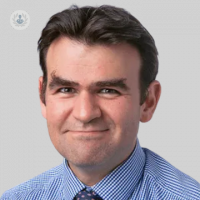Sarcoma: Expert insight on the key signs to look out for
Escrito por:Sarcoma is a form of cancer which can develop in the bone or in part of the body’s soft tissues, including cartilage, fat, muscle or fibrous tissue, amongst others. In this informative article, revered consultant plastic surgeon and service lead for Wales’ sarcoma service Mr Thomas Bragg explains how the condition is managed and treated. The leading specialist also reveals the key signs and symptoms of sarcoma to look out for.

What is sarcoma?
Sarcoma is a rare malignancy which can affect both soft tissues and bone. Sarcomas occur with a frequency of about thirty-five per million head of population, so there really aren't very many of them.
I run the sarcoma service for Wales and here, we generally have somewhere between one hundred and fifty and one hundred and eighty sarcomas a year. In Wales, we don't treat bone tumours and retroperitoneal sarcomas and these patients are sent directly to our colleagues in Birmingham who run the super-regional centre. However, we do manage soft tissue tumours here in Wales through a hub and spoke model which is centralised around Swansea but is also delivered in Cardiff.
What are the main risk factors associated with sarcomas?
In the vast majority of people with sarcomas, we don't identify any cause behind their condition. In very few cases, people may have some very rare genetic conditions which predispose them to getting sarcoma. In addition, for a very small number of patients, sarcoma can result from other treatments.
What are the early warning signs to look out for?
This is an area that we are keen to highlight as a service as this applies to the population at large. We advise looking out for the four ‘red flag’ signs, which relate to lumps which are:
- bigger than five centimetres
- deep (as opposed to something you can feel underneath the skin) and occur around your muscles or adjacent to bones
- growing in size
- painful
If you observe any of these signs, it’s important to see your GP.
What is the general outlook for patients with sarcoma?
Sarcoma is a very broad ranging diagnosis with around a hundred or more different subtypes which are all associated with a varying prognosis, treatment and ongoing management. Therefore, the outlook varies according to an individual patient and their tumour.
In simple terms, anybody who is concerned that they have a lump which is bigger than five centimetres, is growing, that can be painful and feels deep, should see their GP without delay and ask to have an ultrasound scan. At that scan, a consultant radiologist will be able to assess not only the location and the size of the lump, but will also be able to assess whether it has some of the features which may indicate a soft tissue malignancy. If they are concerned that this may be the case, they will perform an ultrasound-guided biopsy. The results from this biopsy and the ultrasound scan will then be discussed at the sarcoma multi-disciplinary team (MDT) meeting.
How is sarcoma managed and treated?
The condition is managed in conjunction with the sarcoma MDT, a service which I now run and am involved with on a weekly basis.
Usually, the management is surgical and involves removing the lesion and then reconstructing patients. We then re-discuss the patient’s case at the sarcoma MDT to see whether additional treatment modalities, such as radiotherapy or chemotherapy, could also be of benefit. We then keep patients under follow-up and see them every three months for the first three years, every six months for years four and five and then annually up to the ten year mark. We take a chest X-ray at each of those follow up appointments to survey the lungs.
If you are concerned about sarcoma and wish to schedule a consultation with Mr Bragg, you can do so by visiting his Top Doctors profile.


